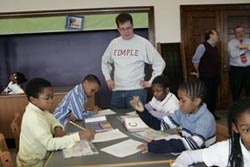A grant from the National Science Foundation will provide kids at three of Temple’s Partnership Schools with a practical approach to science
Sure, those videos on YouTube of kids putting Mentos into a bottle of Diet Coke to see how high the soft drink shoots into the air are funny.
But, they’re also a way for kids to see how some of the things they learn in science class can translate into real life.
Thanks to a new grant received by the College of Science and Technology, the Partnership Schools and the College of Education, students in grades five through eight will get a chance to see what other ways there are to get interested —and stay interested —in science.
The three Temple entities received a $799,125 grant from the National Science Foundation to implement the Science in the City program, which is designed to give students in three of the Partnership Schools — Dr. Tanner G. Duckrey, Joseph C. Ferguson, and General George G. Meade — after-school instruction in science, said John DiPaolo, executive director of the Partnership Schools.
The fourth Partnership School, the Paul Laurence Dunbar School, is not a part of the grant in its initial phase, DiPaolo said, but his office hopes to add similar programs there later.
The idea behind Science in the City is to find a way to help fifth- through eighth-grade students in grades 5-8 retain their curiosity about things scientific by showing them how they can learn about the world through doing science, and how science can lead to jobs and careers, DiPaolo said.
“We want to get them excited about it,” he said. “Most of the things we’ll be doing are enrichment programs that will take place after school or during the summer. They’ll be hands-on learning experiences.”
These experiences will feature the work of such entities as the City of Philadelphia’s police crime lab, the Wagner Free Institute, the New Jersey Academy of Aquatic Sciences, the federal Food and Drug Administration, the Kimmel Center for Performing Arts, the Philadelphia Museum of Art and the Philadelphia Water Company, according to the grant.
Business partners helping with the effort include Turner Construction, Fox 29 News, URL Mutual Pharmaceutical Company and John Wiley Publishers.
While students will certainly have the most fun in Science in the City, teachers will benefit from the program as well, says Susan Jansen Varnum, a professor of chemistry in the College of Science and Technology. While the students will get to participate in the activities, the teachers, with the help of College of Education Professor Diane Jass Ketelhut and consultant Judith Stull, will get professional development designed to help these students build on their after-school and summer sessions, she said.
Science in the City was one of 13 programs nationwide to receive the NSF grant.
